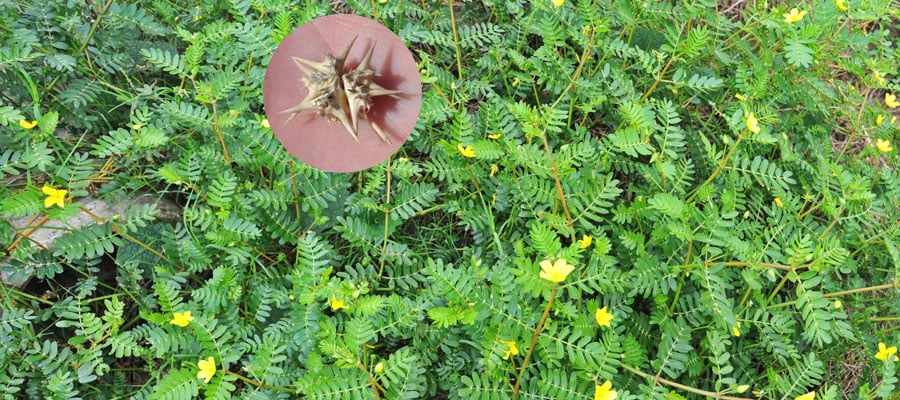Maybe you've had an experience explaining some of the hazards of Idaho living to out-of-state friends and relatives—or maybe you just told someone who doesn't live here that there are goat heads alongside the road everywhere this time of year. To their shocked stares and confused questions, you've probably answered, "Oh, not actual heads of actual goats… stickers or thorns. You know, goat heads."
Any Treasure Valley resident knows that the end of summer in our area brings lovely cool mornings, breezy skies, and painful stickers called goat heads. If you've ever experienced a thorn lodging itself into your foot, shoe or bike tire, you know how nasty these little buggers truly are. They're sharp, hard, and invasive. For pet owners, goat heads pose a particular problem: your dog's paws injured while they run around in the cooler weather. Without proper precautions and handling, a goat head could cause your dog significant pain and even infection. Here's what you need to know.
Preventing and Treating Goat Head Problems
Goat heads grow on puncture vines, a prolific weed that can get by in the hottest, driest of summers. When the vine begins to die, the seeds—goat heads—dry and harden, and their signature spikes becomes needle-sharp spears ready to attach itself to any unsuspecting passerby. This is how puncture vine propagates: by relying on animals and people to move the seeds from place to place.
Preventing Goat Head Injuries
To ensure that your dog doesn't get one of these painful seeds stuck in their paw, scope out any areas you'll be bringing your pet. Keep your dog close by and on their leash if you suspect there may be goat heads in your vicinity. Keep your own lawn weed-free, and if a goat head or two come home with you on your shoe, immediately dispose of them, so they don't have a chance to grow on your property.
Do you know what plants are harmful to your dog or cat? Get the ebook here.
Treating Goat Head Injuries
If your dog has a goat head stuck in his or her paw, you'll know quickly: they'll likely limp, whine, and lick or gnaw the affected foot. You should take immediate action since your dog is in pain and a goat head could cause infection.
- Stay calm and keep your dog relaxed: If you're out, find a place where you can get down on your dog's level, out of the sun, and away from potential distractions like traffic or other dogs and people. Talk to your dog in a low, soothing tone and reassure her that you're here. You'll want your dog to be able to stay still while you remove the goat head.
- Offer your dog a treat: If you have one with you or are at home, offer your dog a treat. This will keep your dog distracted and busy for a while so you can assess the situation. If you can, recruit some help: one person can keep the treats coming while you find the problem.
- Remove the goat head: You'll want to grab tweezers for this part since goat heads aren't pleasant to grab hold of firmly. With your tweezers, gently remove the goat head in a swift motion. Check to be sure you've gotten all of it: if you haven't, try to remove the point. If you can't remove the end, call your veterinarian immediately.
- Wash up: A wound on your dog's paw could cause infection, so disinfectant soap and water are the best way to finish up your operation. Wash your dog's paw thoroughly.
If you notice that your dog continues to favor their paw, call your veterinarian. An infection may be flaring up, and your veterinarian can give your dog the proper care to prevent more pain. Contact us with any questions.
